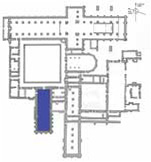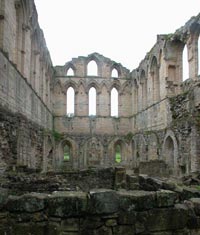 |
 |
 |
 |
 |
 |
 |
|
The refectory
For them everything is fixed by weight, measure
and number.
A pound of bread, a pint of drink, two dishes of cabbage and beans.
If they sup, the remnants of their former meal are dished up again
except that, instead of the two cooked dishes, fresh vegetables,
if
they are to be had, are served.(1) The first stone refectory at Rievaulx dates from the mid-twelfth century, and lay parallel to the cloister, on an east/west axis. At the end of the twelfth century the refectory was completely rebuilt with the new building running along a north/south axis. This meant that the kitchen could now be accommodated in the southern range and accessed directly from the cloister. The sheer size of the new refectory was impressive: it stood over fifteen metres high and extended over fifteen metres in length; on account of the terracing of the site, the building was raised with cellarage below. The interior was equally striking for the walls were lime-washed light pink with a masonry pattern traced in red and a tiled floor. Indeed, Rievaulx’s new refectory was one of the finest in the country, but it is likely that the cost of its construction, which involved buying materials and paying outside workers, was a major factor contributing to the community’s debt in the late twelfth century.(2)
|
 (1/1)
(1/1)